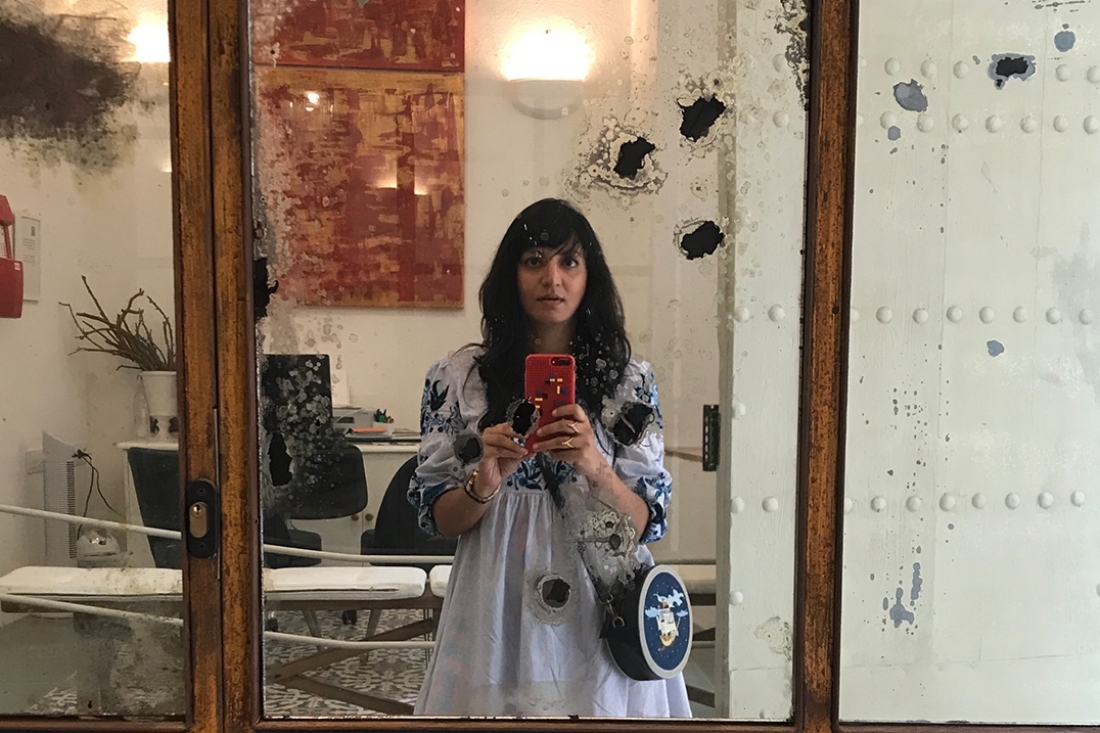
Dhara Jain

Dhara Jain
The fun set, space and production designer for films and advertisements, most recently whose work you saw in the adorable Tumhari Sulu, shares with us her journey through the craft.
Can you take me through your journey in production designing?
It was by fluke that I landed up in Production Designing. Being a student at NIFT, MTV [now Viacom18] thought I was a costume stylist and so called me for an interview. My portfolio passed many alleys of the office and finally I was directed to the art director in the MTV Studio who never really looked at my fat folio on communication design. He just asked me one thing—if I could come at 4am and leave maybe never, travel to odd places at odd hours and communicate well with workers. And so well there I was—between buckets of paint and sheets of plywood and free to experiment in that big ass studio.
After leaving MTV, I wanted to work only with a select few production designers. I was nor looking to make it big or be part of massive set constructions; rather I was interested in character development of spaces, knowing how backgrounds needed to blend in to the narrative and getting ready the correct atmosphere for the actor to perform. I did, to my luck, work with all of the Production Designers in my little list and now can actually boost about how well I have been brought up! Also, I cannot thank them enough for they imparted the most important lessons to my art education.
What inspires your design aesthetic?
I have stopped being biased to what people perceive as beautiful or aesthetically correct or appealing to the eye, or even disturbingly grotesque.
My job is primarily to establish the overall visual look and feel of a film. The settings, spaces and the images that we create should serve as the film’s backdrop and help develop its narrative and therefore support the character identities. We build to blend where the actor must belong, to blend the set/location to his/her reality.
I want to know everything and catch details on activities you would not even consider looking at. It’s funny sometimes—what all I stop and stare at and oh! I can scan something/someone in a second that is rather creepy!
Tell me about some of the films and people that have had a significant impact on you as you worked on, and with them.
I think every film that I have had the opportunity to work on, big or small, has had its own story and an innings that came with various good, bad, nervous and ecstatic moments.
If I do have to pick one, it has to be Bombay Velvet [Phantom production], directed by Anurag Kashyap. I spent two long years on it, from beginning to end. A period film for any art enthusiast is a dream-come-true, and with the team that we were, the magnitude and the detailing that we expected from ourselves and working with a director that builds his characters so strong—all of it shaped our design thoughts to another level. I walked into every library in Bombay and scrolled through every possible blog I could find. I remember reading a review comment saying that the news supporting the article of the prop newspaper was correct to the times—and yes, it was. I also share a special corner for Ranbir Kapoor and Vidya Balan for they have a powerful presence that changes the energies around.
How has a production designer’s responsibility evolved over the years?
Our responsibility is interestingly increasing – we build on metaphors, social messages, space history, reflective moods and sounds and also many a times extend back stories and information to better characters and spaces and to transport you into the film itself. We, collectively – Production Designer, Director of Photography, Costume Director are creating an environment which may or may not exist, but is there in the director’s vision or the writer’s screenplay.
Take us behind the ground scene of production designing in the country—how far have we come and how far are we yet to go? Where do we stand vis-à-vis global cinema?
Oh! Thankfully we have come a long way. Production Design, like any art form, has been evolving and changing with a lot of new and experimental designers, visual artists, 3D and 4D artists, illustrators, visual effect supervisors etc joining hands. Which is good; I am proud, but we are way too slow and don’t like to share resources and contacts. We are an insecure lot really—very few share despite there being an abundance of human resources and talent. And therefore it saddens me to accept that we are far behind when compared to global cinema. Despite more people being interested in design and art, we need an increase in the number of mechanical and technical engineers working with production designers. While we struggle to still have moving setups with walls on wheels, there are real auto-bots and transformers being used globally. We have one taxidermy artist left in the country and out abroad are birds flying and animals getting skinned that look as real as can be. Our labour shies away from using any kind of technology and safer, convenient ways of working— say using forklifts unless forced upon. And of course, our 30 men shifting walls falls cheaper. Also while India supplies textiles and manufactures armor for the west, we sitting in our own country don’t know how to use our own resources to their potential.
What are you currently working on and what is next?
After Tumhari Sulu, I will now work on some television commercials, and am soon be occupied with Excel Entertainment’s next feature film, Gully Boy, directed by Zoya Akhtar —very excited about this one!
Text Soumya Mukerji